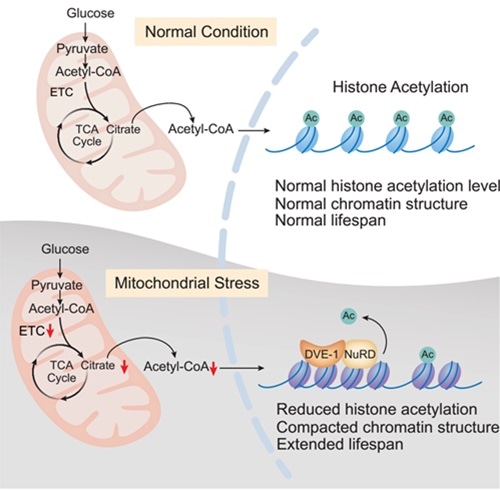Scientists from the Institute of Genetics and Developmental Biology of the Chinese Academy of Sciences have recently demonstrated that acetyl-CoA—a mitochondrial metabolite—connects mitochondrial stress to the nuclear epigenome through the NuRD complex for regulating the life span in C. elegans.

Model of acetyl-CoA links mitochondrial stress to longevity via NuRD-mediated chromatin remodeling. Image Credit: IGDB.
The study was published in the Science Advances journal.
Aging and metabolic homeostasis are closely associated with each other. The mitochondria contain a regulatory center for cellular metabolism. Besides producing a huge quantity of adenosine 5′-triphosphate (ATP), mitochondria also create several molecules like intermediate metabolites, heme, and lipids that constantly interact with the rest of the cell, enabling cells to incorporate energy demand and nutrient availability to guarantee the metabolic homeostasis of cells.
A study conducted in C. elegans has demonstrated that when mitochondrial stress occurs during early life, it causes an extensive restructuring of chromatin that is crucial for activating the mitochondrial unfolded protein response (UPRmt)—a procedure that supports the recovery of stress-induced longevity and mitochondrial protein homeostasis.
The scientists detected the NuRD complex that is responsible for mediating the nuclear build-up of DVE-1—the UPRmt transcription factor—in response to mitochondrial stress. The scientists also noted that the damaged tricarboxylic acid (TCA) cycle following mitochondrial stress leads to reduced concentrations of citrate, which is responsible for reducing the production of acetyl-CoA and, as a result, induces nuclear accumulation of the DVE-1 and NuRD, allowing reduced acetylation of histones and reorganization of chromatins.
The acetyl-CoA level can be restored by providing nutrients and substrates essential for the production of acetyl-CoA. This method is adequate to neutralize the changes in the chromatins and reduce the longevity following mitochondrial stress.
The researchers’ results reveal a new molecular mechanism of the metabolite-mediated epigenome for the control of organismal aging.
Source:
Journal reference:
Zhu, D., et al. (2020) NuRD mediates mitochondrial stress-induced longevity via chromatin remodeling in response to acetyl-CoA level. Science Advances. doi.org/10.1126/sciadv.abb2529.